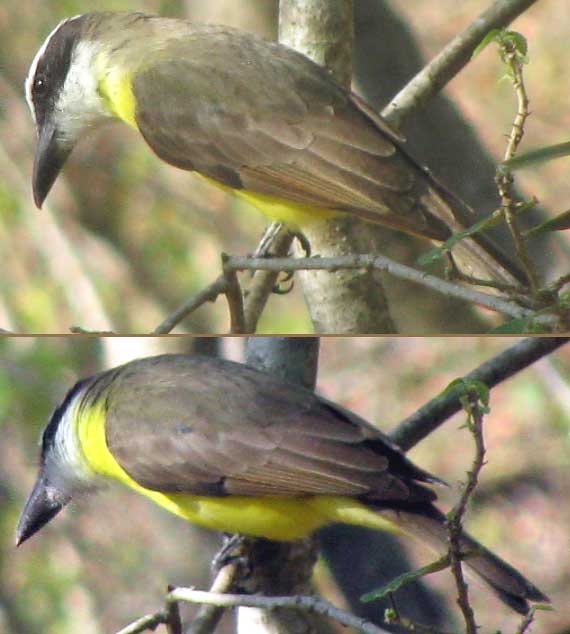Excerpts from Jim Conrad's
Naturalist Newsletter

from the March 28, 2010 Newsletter issued from Hacienda Chichen Resort beside Chichén Itzá Ruins, central Yucatán, MÉXICO; limestone bedrock, elevation ~39m (~128ft), ~N20.676°, ~W88.569°
FLYCATCHERS WITH BIG BILLS
Camouflaged beneath my old poncho next to the haltún watering holes, I watched six Social Flycatchers cavorting, clearly less interested in drinking water themselves than keeping others of their flock from landing at the water first. CHIIR t-CHIIR t-CHIIR they shrilly and monotonously called. Then two birds colored and patterned just like them flew among them, perched quietly and looked around. Despite the nearly identical color patterns, the two new visitors were strikingly larger. Two images of one of the visitors are shown above.
You can compare the visitor with a Social Flycatcher at www.backyardnature.net/yucatan/social-f.htm.
Two images of one of the visitors are provided so you can see the bird's bill from both the side and from below. For, the visitors were Boat-billed Flycatchers, MEGARYNCHUS PITANGUA, distinguished by their heavy, wide beaks. It's good to know about the Boat-billed's beak because not only are Boat-bills colored and patterned like Social Flycatchers, but also Great Kiskadees, and all three of these species are common throughout much of the American tropics. Their similarity causes identification problems for newly arrived birders.
Of the three species, visually, Social Flycatchers are the easiest to separate from the others because of their small size. Boat-billed Flycatchers are about 9.5 inches long (24 cm), about the size of an American Robin, while Great Kiskadees are close to that, averaging only about half an inch longer, but Social Flycatchers reach only about 7 inches long (18 cm).
Great Kiskadees display much more rustiness in their upper bodies than the mostly gray-brown Boat-billeds. Sometimes the amount of rustiness doesn't show so well, though, and then you need to see that bill.
Fortunately, all three of these look-alike species are fairly easy to differentiate by their calls, and they tend to call a lot, loudly and shrilly. Kiskadees almost say their name, ki ke-REEH. Socials do a great deal of varied, excited twittering and bickering, while Boat-bills have a somewhat grating EEIHRRRR, shrilly rising toward the end.
These three look-alike flycatchers aren't nearly as closely related to one another as, say, a Yellow- rumped Warbler and a Magnolia Warbler. All three flycatcher species belong to different genera.
When you remember that the North's kingbirds and Myiarchus flycatchers also tend to have gray-brown upper parts and yellowish underparts, you wonder why flycatcher species seem to benefit from this precise combination, and whether the combination arose from an ancestor they all have in common, or from convergent evolution, or some combination of the two processes.